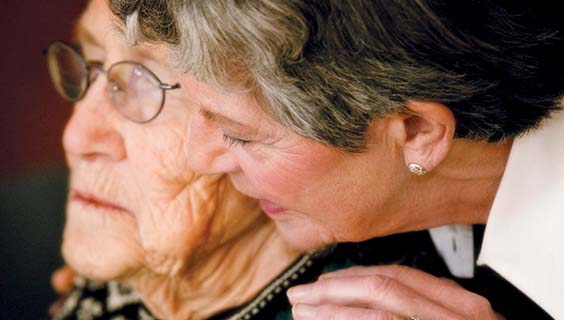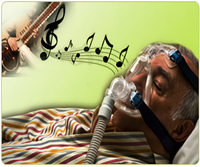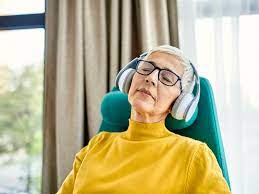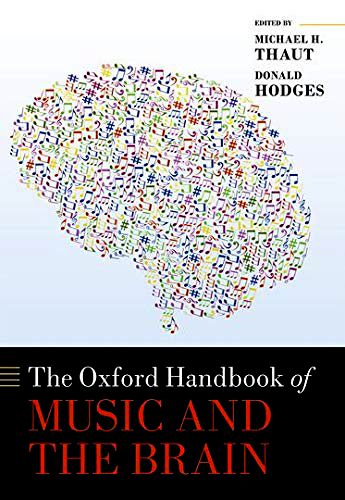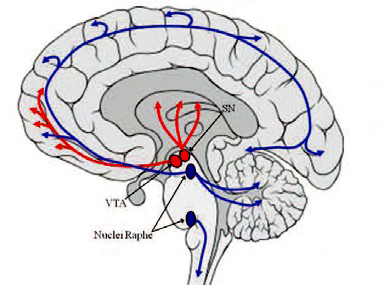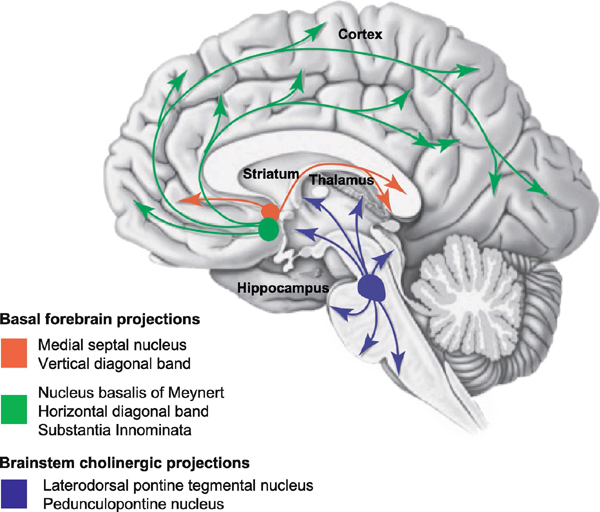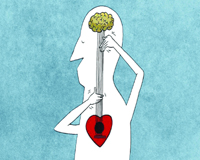Music therapy
Multi-sensory approaches of music in the brain — II
Abstract
The growing number of mental health problems in the older adult population during the pandemic is a global health concern. Difficulties with emotional, psychological and psychosocial needs can lead to anxiety, depression, loneliness, mood and stress disorders. The evidence-based treatment plan of music therapy can be used as an effective tool for mental health professionals. Co-related studies on music and emotions reveal that the therapeutic effects of music on the ageing brain might be due to the various simulations in brain processing. In this paper, the whole explanation is divided into two parts and an attempt is made to find the interconnected explanations of multi-sensory approaches of music in the brain and neuro-chemical responses to induce positive emotions for well-being in older adults. This paper tries to investigate some facts about the holistic approach of music therapy as an effective tool in mental health practices and rehabilitation for older adults with Parkinson’s disease.
Being a mental health professional and neurological music therapist, most of the time I apply the techniques of music therapy and use them as a tool for my mental health practices with clients. In this paper, I try to answer some questions which are very basic in nature and which I came across during my practice as a mental health professional. In the first part, I describe some case studies of the so-called ‘transfer effects’ of musical activities on non-musical tasks for better mental health in the old-age population, and which is linked with cognitive reserve, along with music-induced physiological effects, which are related to mood and reward modulations due to the emotional aspects of music. The second part of this is based on various research studies of neuro-chemical responses in the brain related to music and the emotions. The third part of the paper provides the conclusion based on case studies and previous research papers which advocate music therapy as an effective tool in mental health practices and rehabilitation for older adults with Parkinson’s disease.
Case studies
• Skill/area targeted — depression/sadness Age group — 4 older adults with Parkinson’s disease, aged 60-80 years. Participants must have at least a minimum level of verbal communication and musical training
• Setting — individual music therapy session (weekly twice)
• Tools — tele-health practices in neurological music therapy
• Techniques —therapeutic singing (TS), Music in psychosocial training and counselling (MPC)
• Music selection —Rabindra Sangeet, Indian classical music, instrumental flute music
• Equipment needed — recorded music, laptop/computer, phone, harmonium, electronic tabla
Design
This study of 40 individual music therapy sessions sought to find the relationship between musical improvisation (Rabindra Sangeet, Indian Classical Music along with flute instrumental music) and the emotional processing of older adults with Parkinson’s disease. Four female older adults, in an age group of 60-80 years were selected, who had faced Parkinson’s disease for over the last 5-7 years. All four experimental subjects had a musical background and had learnt music in their childhood, especially Hindustani classical music and Rabindra Sangeet. On the basis of the current need assessment of each individual, the model was designed on the evidence-based music therapy treatment plan for good mental health, to cope with their current condition.
We selected tele-health practice as a tool for music therapy and therapeutic singing (TS), and music in psychosocial training and counselling (MPC) as a technique based on the needs assessment of individuals. Each 60-minute individual session was divided into four parts, including guided music listening, music and movements, expressive improvisation and composition exercise. These musical performances were designed to address issues of mood-control, reality orientation, affective expression, cognitive coherence and appropriate social interaction to facilitate psychosocial functions and induce positive emotions. We divided the four individuals into two separate groups, each having a separate model of improvisation followed by guided music listening. The first group of two had twenty individual 45-minute sessions of Rabindra Sangeet improvisation, followed by 15 minutes of flute with natural sounds and instrumental music listening. The post-session assessment of each individual exhibited more positive emotions, were higher in energy with a good happiness index and better social interaction and mood elevation.
Then the second group of two older adults had twenty individual 45-minute sessions of Hindustani classical music improvisation model, followed by 15 minutes of flute with natural sounds and instrumental music listening. At the post-session assessments of both individuals, they showed no significant change in mood alleviation, and expression of emotions, but were high in the happiness index, relaxation and social interaction. The assessment findings advocate that the rhythm, poetry, lyrics and song-writing parts of Rabindra Sangeet gave them a better way to express their emotions and were more significant in behavioural measurements as they included musical performance features, note density, note duration, distribution mode, note maxima and minima based on the highest and lowest pitch, song sentiments in comparison to Hindustani classical music. On the other hand, the timing and combinations of rhythms in raagas gave the subjects a sense of relaxation, calmness and happiness.
Conclusion
These case studies of 4 female older adults with Parkinson’s disease reveal that difficulties in the emotional well-being of older adults, which can lead to depression and loneliness, might be due to intense life-changes, physical decline, hormonal changes, cognitive changes or social changes due to their disease affliction. Music has a medicinal capacity and a tremendous power to trigger strong emotions and evoke intense pleasure to modulate mood and arousal. The improvisation of selected Rabindra Sangeet music modulates the mood and helps the subject towards a heightened expression of emotions and triggers a stronger happiness index. On the other hand, the improvisation of selected raagas from Hindustani classical music activates happy hormones and triggers relaxation.
Physiological responses (heart-rate and hormone release) and brain activation in the mesolimbic system are related to the evoked emotions associated with musical activities. Some research papers on mental health and music therapy advocate the findings that musical activities and group music therapy programmes help older adults in connecting with other people, in developing self-identity, in maintaining a good social bonding and in increasing self-esteem, thus decreasing feelings of loneliness and isolation and increasing the quality of life and emotional well-being.
Furthermore, we can use music as an emotional stimulus for musically inclined older adults to express and experience spirituality and use it as a tool for the evocation of autobiographical memories. Positive emotions and satisfaction of psychological needs are important factors for human overall well-being. Some research studies advocate that positive emotions were the most frequently felt feelings in response to music. With the help of music therapy sessions, the response of psychological needs, such as emotional functions (e.g., mood regulation, pleasure, relaxation), issues of identity and belonging is based high in the choices of music.
Research
Lai and Good describe that listening to forty-five minutes of relaxing music at bedtime improves sleep quality, duration and efficiency, thus reducing daytime dysfunctions in a group of older adults with sleeping disorders(1). Listening to good music before going to sleep reduces older adults’ depression levels together with stabilising the heart rate, blood pressure and respiratory rate. Beyond listening to music, practising a musical activity or attending music therapy sessions can significantly contribute to health and emotional well-being. Some studies suggest that playing musical instruments, participation in community group-recitals and taking active participation in any musical activity resulted in lower levels of depression, more positive mood states, better quality of life, and social interactions, when compared to other leisure activities.
The brain mechanism
The stimulation and emotional power of music induced physiological changes and is associated with increased activation in the core emotion network, including amygdala, hippocampus and in mesolimbic striatal regions associated with dopamine release and promotes brain plasticity. Furthermore, music promotes positive emotions and modulates the level of relaxation, motivation and pleasure, thus increasing holistic well-being and social connection. Indeed, music stimulation increases and preserves not only grey matter but also brain-connectivity, usually impaired by ageing processes. They ultimately focus on musically-inclined activities as a powerful tool in fighting against ageing-related emotional and cognitive impairments. In 1999, the first brain-imaging studies focusing on emotions in music were documented by Blood, Zatorre, Bermudez and Evans. Here they used positron emission tomography to examine cerebral blood-flow (CBF) changes related to affective responses to music (2).
Neuro-chemical responses to music
Michael H. Thaut and Donald A. Hodges in their book, The Oxford Handbook of Music and the Brain described the effects of neuro-chemical responses to music with the help of various research papers. They divided the neuro-chemical responses in seven specific systems in the brain. Knowledge of these responses and neurochemical functions might help therapists and mental health professionals to uncover more significant effects of music in various brain functions and help them to understand brain pathology in a better way. With the help of neuro-imaging techniques and peripheral bio-markers, these music-induced effects can be objectively assessed (3).
Dopamine System
Endogenous Opioid System
Serotonin System
Neuro-endocrine systems-1 (posterior pituitary)
Neuro-endocrine systems-2 (anterior pituitary)
Norepinephrine System
Cholinergic System
Dopamine system
Dopamine (DA) is synthesised in the cytosol of catecholaminergic neurons in the ventral tegmental area VTA and in the substantia nigra pars compacta of the brain. The DA pathways are commonly called mesocorticolimbic and nigro-striatal pathways. The first pathway is associated with emotional/motivational functions, whereas the second is associated with cognitive/executive and sensorimotor functions.
Endogenous Opioid system
The central endogenous opioid system (EOS) namely consists of three opioid peptides, including b-endorphin, enkephalins, and dynorphin. The EOS involves various functions, including pain modulation, reward, stress responses and autonomic control. Central EOS plays an important role in the pleasure and positive affect induced by music, which act synergistically with Dopamine. Both EOS and DA systems are associated with reward mechanisms, motivational aspects and pleasure.
Serotonin system
The raphe nuclei of the brainstem synthesised Serotonin (5-HT). Serotonin is related to the induction of behavioural states such as stress and emotional behaviour as well as directly implicated in various psychiatric and neurologic disorders. Serotonin association with depression, anxiety disorders, obsessive-compulsive disorder, dementia and post-traumatic stress disorder is well documented. Many studies revealed the relationship between music and Serotonin as music is used as a modulator for various activities in the brain associated with emotions, along with musical activities that can influence social behaviour and interaction.
Neuro-endocrine systems — 1
Oxytocin (OT) and Arginine Vasopressin (AV) are two neuro-peptides released from the posterior pituitary. Many research papers have supported the findings of a close association between the neuro-endocrine system and social behaviour, social cognition, reproductive behaviour, social affiliation and some implications in psychiatric disorders, such as autism spectrum disorders. Several studies advocated peripheral OT responses to musical activities.
Neuro-endocrine systems — 2
This system, referred to as the hypothalamic-pituitary-adrenal (HPA) axis, releases cortisol as its main effector hormone, which plays a pivotal role in circadian and stress regulation. Several research papers investigate cortisol as a stress bio-marker in response to music. There are some studies suggesting that music in general may reduce cortisol levels. In music therapy, where musical and other activities are led by a therapist, showed mixed results. Following guided imaginary and music (GIM) therapy, that combines relaxation techniques and listening to classical music, the cortisol level was reduced lower, compared to the silent condition in healthy participants.
Norepinephrine system
The activation of the sympathetic nervous system, induced by physical or psychological stressors, releases norepinephrine, which stimulates the adrenal glands that synthesises and secretes hormone norepinephrine, epi-nephrine, and dopamine. Norepinephrine neurons are located in the brainstem, primarily in the locus coeruleus, whose axons widely project to the cerebral cortex, limbic regions, thalamus, and cerebellum as well as to the spinal cord. Major NE projections are playing an important role in stress responses and various psychiatric disorders. Some research studies revealed that music therapy sessions with the elderly who had Parkinson’s and cardiovascular disease lowered the plasma NE level, compared to those without music therapy.
Cholinergic system
Cholinergic neurons are localised in the basal forebrain and pontomesencephalic tegmentum (PMT) nuclei. The PMT nuclei send projections to the spinal cord, thalamus, basal forebrain and frontal cortex. Auditory stimuli,activating the primary auditory cortex, may be able to affect the activity of cholinergic neurons in the PMT, influencing various functions such as arousal, the sleep-wake cycle, motor control, and motivation and reward behaviour.
The impact of music therapy and musical activities on emotions and well-being is important for normal ageing, while it becomes crucial in pathological ageing. Problems like anxiety, apathy, depression and agitation are indeed hard challenges for patients as well as therapists when dealing with older adults with Parkinson’s disease. Through this paper, I have tried to elaborate the correlation between music therapy and mental health practice. Here, we highly advocate the use of music therapy as an effective tool in mental health practice and the rehabilitation of older adults, especially those with Parkinson’s disease. The combined model of improvisation includes selected Rabindra Sangeet and Hindustani classical music, followed by instrumental music that trigger neuro-chemical responses through brain mechanisms that can modulate mood, pleasure and relaxation to fulfil the psychological needs of older adults.
The correlation of music and emotion has been studied by various researchers since 1999 to now and they have established the theories of neuro-chemical responses of music for overall good emotional well-being. Research and evidence on multi-sensory approaches of music in the brain advocate the therapeutic effects of music therapy in mental health practices and rehabilitation to satisfy not only psychological needs of older adult populations but also the psychosocial needs for achieving overall well-being.
References
1. Lai HL, Good M. Music improves sleep quality in older adults. Journal of Advanced Nursing 2005; 49 (3): 234-44.
2. Blood AJ, Zatorre RJ, Bermudez P, Evans AC. Emotional responses to pleasant and unpleasant music correlate with activity in paralimbic brain regions. Nature Neuroscience 1999; 20 (2): 382-87.
3. Thaut MH, Hodges DA. The Oxford Handbook of Music and The Brain. Oxford: Oxford University Press; 2019, pp. 333-63.
Aradhana Deogharia is a neurological music therapist and the Founder and President of NAVYA Foundation, USA.
Share with us (Comments,contributions,opinions)
When reproducing this feature, please credit NAMAH,and give the byline. Please send us cuttings.


